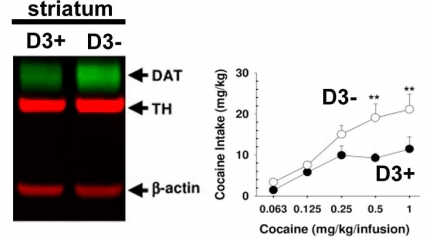Results from a recent study in a mouse model of cocaine addiction suggest that the type 3 dopamine receptor (D3R) may play a protective role against the addictive power of cocaine. When researchers deleted the D3R gene, the resulting D3R knock-out mice displayed increased cocaine-seeking and taking behaviors. D3R knock-out mice also show increased expression of dopamine transporters (DATs) in the striatum--a part of the brain involved in reward. Since DATs are in charge of removing excess or left over dopamine from the synapse, increased DAT activity could blunt the cocaine-driven dopamine spike, which, in turn, could lead these mice to try and compensate by taking more drug. If this finding generalizes to humans, individuals displaying lower D3R availability could be at increased risk for the development of cocaine addiction. (Song et al, 2012)
Reference
Song R, Zhang HY, Li X, Bi GH, Gardner EL, Xi ZX (2012). Increased vulnerability to cocaine in mice lacking dopamine D3 receptors. Proc Natl Acad Sci U S A 109(43): 17675-17680.

